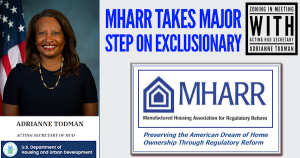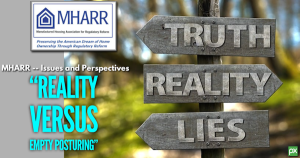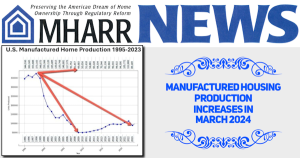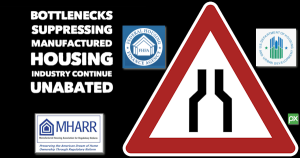MHARR Calls for Mainstream Manufactured Home Loans to Be Included in Enterprise Housing Goals
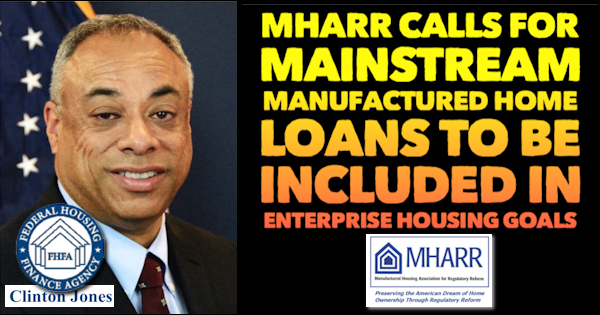
Washington, D.C., March 1, 2021 – The Manufactured Housing Association for Regulatory Reform (MHARR) has filed comments copy attached with the Federal Housing Finance Agency (FHFA) calling for the inclusion of mainstream manufactured home personal property or “chattel” loans — once again – within the Agency’s Enterprise Housing Goals (EHG) for mortgage giants Fannie Mae and Freddie Mac.
In its comments, filed on February 26, 2021 in response to an FHFA Advance Notice of Proposed Rulemaking (ANPR) concerning the next iteration of the Enterprise Housing Goals, MHARR noted that prior to 2010, mainstream manufactured home “chattel” loans, which comprise nearly 80% of the manufactured home consumer lending market and provide consumers with access to the industry’s most affordable homes, were, in fact, eligible for EHG credit. That year, however, FHFA amended the EHG regulatory definition of “mortgage” to exclude personal property manufactured home loans and instead shifted the entire issue of Enterprise support for such loans to its Duty to Serve Underserved Markets (DTS) program, noting that FHFA “could revise the definition of ‘mortgage’” once again, in a “future rulemaking” to include chattel loans and “ensure conformance with a final” DTS regulation, based on information obtained through DTS on the performance of such loans. Of course, though, as MHARR emphasizes in its comments, this has turned into a dead-end for such support, as neither Fannie Mae nor Freddie Mac have purchased a single manufactured home personal property loan, and any initial plans for “pilot program” chattel purchases by the Enterprises under DTS have been eliminated in subsequent plan “modifications” approved by FHFA.
By thus tying manufactured home chattel loan participation in EHG to thus far non-existent support for such loans under DTS, FHFA has created a “perfect storm” of malign neglect for the vast majority of lower and moderate-income American families seeking to realize the American Dream of homeownership via inherently affordable manufactured homes – directly contrary to Congress’ objectives for both EHG and DTS.
Put differently, with no manufactured home chattel loan purchases under DTS, no “information” has been developed by Fannie and Freddie regarding the performance of manufactured home chattel loans under DTS. This failure has – first and foremost — been bootstrapped by the Enterprises for some 13 years, as a self-fulfilling prophesy, to continue avoiding manufactured home chattel loan purchases indefinitely. Simultaneously, though, because of FHFA’s express link between EHG and DTS with regard to such loans, the absence of performance information through DTS has also been used by FHFA as an ongoing excuse to exclude manufactured home chattel loans from EHG. Thus, FHFA in 2018, refused to re-incorporate chattel loans in EHG, stating, “[B]ecause neither Enterprise has purchased chattel loans on manufactured housing in recent years, there is limited data available on the market for such loans or their performance. As a result, FHFA would be unable to set benchmark levels for this market segment or assess the impact of any Enterprise purchases on their housing goals performance.” Consequently, under the EHG-DTS linkage established by FHFA in 2010, the Enterprises’ continuing failure to serve the manufactured home chattel market under DTS is offered as justification for FHFA’s failure to restore EHG credit for such loans – with American consumers of affordable housing paying the ultimate price for this abject and inexcusable policy failure.
MHARR’s comments, consequently, call on FHFA to end this baseless charade, and: (1) require market-significant purchases of mainstream, affordable manufactured home personal property loans under DTS; and (2) simultaneously restore EHG credit for such purchases based on the known and well-documented affordability of both mainstream manufactured homes and chattel financing.
The Manufactured Housing Association for Regulatory Reform is a Washington, D.C.-based national trade association representing the views and interests of independent producers of federally regulated manufactured housing.
VIA FEDERAL EXPRESS AND ELECTRONIC SUBMISSION
Hon. Clinton Jones, Esq.
General Counsel
Attention: Comments/RIN 2590-AB12
Federal Housing Finance Agency
Eighth Floor
400 7th Street, S.W.
Washington, D.C. 20219
Re: Advance Notice of Proposed Rulemaking – Enterprise Housing Goals
Dear Mr. Jones:
The following comments are submitted on behalf of the Manufactured Housing Association for Regulatory Reform (MHARR). MHARR is a Washington, D.C.-based national trade association representing the views and interests of independent producers of manufactured housing regulated by the U.S. Department of Housing and Urban Development (HUD) pursuant to the National Manufactured Housing Construction and Safety Standards Act of 1974, as amended by the Manufactured Housing Improvement Act of 2000 (42 U.S.C. 5401, et seq.). MHARR was founded in 1985. Its members are primarily smaller, independent businesses, located in all regions of the United States.
- INTRODUCTION
On December 21, 2020, the Federal Housing Finance Agency (FHFA) published an Advance Notice of Proposed Rulemaking (ANPR) in the Federal Register regarding potential changes to the FHFA-administered Enterprise Housing Goals (EHG) for Fannie Mae and Freddie Mac.[1] The ANPR invites comments from interested parties concerning four specific questions set forth therein, as well as “any other issues that … should be addressed as part of the rulemaking that will establish the housing goals benchmark levels for 2022 and beyond.”[2]MHARR’s comments below, address the specific inclusion of loans on federally-regulated manufactured housing as part of the Enterprise Housing Goals, as well as the need to specifically incorporate and reference manufactured housing loans generated pursuant to the Duty to Serve Underserved Markets (DTS) provision of the Housing and Economic Recover Act of 2008 (HERA) as part of those goals as well.
- COMMENTS
As MHARR has observed in previous comments to FHFA concerning both the Enterprise Housing Goals[3] and the implementation of the statutory Duty to Serve Underserved Markets mandate,[4] federally-regulated manufactured homes[5] are the nation’s premiere source of inherently affordable, non-subsidized housing and homeownership. Indeed, according to the most recent data compiled by the U.S. Census Bureau, the average cost, per square foot, of a federally-regulated manufactured home (exclusive of land) is less than half of the average cost, per square foot, of a site-built home (also exclusive of land).[6] Manufactured housing, accordingly, is the single most affordable type of non-subsidized housing and homeownership in the United States. Moreover, the vast majority of manufactured homes sold in the United States, are financed through home-only personal property or “chattel” loans and are titled under applicable state law as personal property. Census Bureau data thus shows that in 2019, some 76% of all manufactured homes sold in the United States were financed and titled as personal property.[7] By contrast, in the same year, only 19% of manufactured homes were financed and titled as real estate.[8]
Despite the fact that federally-regulated manufactured homes are the nation’s most affordable non-subsidized homes, Enterprise purchases of manufactured housing personal property consumer loans are not — and have not – been eligible for Enterprise Housing Goals credit since at least 2010, when the relevant FHFA regulations were modified. That modification and its implications were addressed by FHFA in its February 12, 2018 final rule establishing the 2018-2020 Enterprise Housing Goals:
“Prior to 2010, the [Enterprise Housing Goals] regulation defined the term ‘mortgage’ to include a loan secured by ‘a manufactured home that is personal property under the laws of the state in which the manufactured home is located.’ FHFA revised the definition in 2010to remove this language and thus to exclude chattel loans on manufactured housing from coverage under the housing goals regulation. The Supplementary Information for the 2010 final rule recognized that the role of the Enterprises with respect to chattel loans on manufactured housing was subject to change, and also stated that ‘FHFA may revise the definition of ‘mortgage’ in future rulemaking to ensure conformance with the final regulation on the duty to serve.’ In December 2016, FHFA published a final rule implementing the statutory … Duty to Serve underserved markets. The Duty to Serve final rule does not require the Enterprises to purchase chattel loans on manufactured housing, but the final [DTS] rule does permit the Enterprises to receive Duty to Serve credit for such purchases to the extent that the Enterprises choose to pursue a pilot initiative for chattel loans on manufactured housing…. While both Enterprises have adopted Duty to Serve plans to pursue pilot initiatives for chattel loans on manufactured housing, those plans are still in the early stages. In addition, because neither Enterprise has purchased chattel loans on manufactured housing in recent years, there is limited data available on the market for such loans or their performance.As a result, FHFA would be unable to set benchmark levels for this market segment or assess the impact of any Enterprise purchases on their housing goals performance. Due to the limited information available at this time, the [2018] final rule does not make any change to the housing goals treatment of chattel loans on manufactured housing. FHFA may propose changes in a future rulemaking based on its assessment of additional information that may become available, especially from Enterprise chattel pilot activities.”
(Emphasis added. Internal citations omitted).[9]
Following the 2010 “mortgage” definition regulatory modification that deleted Enterprise Housing Goals credit for purchases of personal property manufactured housing consumer loans, and notwithstanding FHFA’s stated willingness to restore such credit in a “future rulemaking,” EHG credit for manufactured housing chattel loans has not been reinstated through at least the 2021 Enterprise Housing Goals final rule.[10] Meanwhile, FHFA, through multiple DTS implementation plan modification “approvals,” has allowed both Fannie Mae and Freddie Mac to renege completely on even the minimal manufactured home chattel loan “pilot programs” that were proposed in their initial 2018 DTS implementation plans. FHFA has thus ignored – and enabled Fannie and Freddie to ignore and subvert – Congress’ DTS directive and mandate with respect to the manufactured housing market. Not surprisingly, therefore, DTS has resulted in no reported manufactured home chattel loan purchases by the Enterprises, while both Fannie Mae and Freddie Mac continue to claim, without supporting evidence, that they lack performance information regarding such loans.
The ultimate consequence, therefore, of: (1) the removal of mainstream manufactured home chattel loan purchases from EHG credit in 2010; and (2) FHFA approval of DTS “implementation” plan modifications in 2018, 2019 and 2020 that backtracked from initial projections of minimal DTS chattel “pilot programs” in 2019, 2020 and now, 2021, is that the nearly 80% of the affordable, mainstream manufactured housing consumer loan market represented by personal property loans, has been completely and unlawfully cut-off by FHFA, Fannie Mae and Freddie Mac from the policy-level support and incentivization that Congress sought to establish for affordable housing through the Enterprise Housing Goals and specifically for all types of manufactured housing through the Duty to Serve. Some 13 years, then, after the enactment of DTS, and the corresponding removal of manufactured home chattel loans from EHG credit, FHFA continues to defy the clear will and objective(s) of Congress while simultaneously leaving low, lower and moderate-income American families in need of truly affordable homeownership out in the cold.
Put differently, by tying EHG participation for manufactured housing to expected chattel loan data resulting from DTS implementation – which, after more than a decade, has not occurred — FHFA has created a “perfect storm” for mainstream manufactured housing consumers. As a result, Fannie Mae and Freddie Mac’s complete failure to serve the vast bulk of manufactured home consumer loans under DTS (i.e., the nearly 80% of manufactured home purchases financed through chattel loans) has simultaneously ensured that the same homes and the same loans continue to be excluded from EHG participation – meaning that the Enterprises have no incentive whatsoever to serve the vast bulk of the mainstream manufactured housing consumer lending market, directly contrary to the objectives of Congress with respect to both EHG and the Duty to Serve and directly contrary to the best interests and wellbeing of those low, lower and moderate-income American families.
Meanwhile, and even worse, FHFA has allowed Fannie and Freddie to subvert, evade and effectively hijack DTS within the manufactured housing market by not only failing to serve – at all – the nearly 80% of the HUD Code market financed through personal property loans, but also by diverting DTS support from those mainstream, affordable HUD Code homes to a supposed “new class” of much more costly manufactured home described variously as “MH Advantage” homes, “Cross-Mod” homes and/or “ChoiceHome” homes. As MHARR has previously documented in both written comments and extensive interactions with FHFA officials (i.e., FHFA Deputy Director, Sandra Thompson), those more costly homes are not only unaffordable for the low, lower and moderate-income families that currently and historically relied on mainstream manufactured housing, but are not economically viable for the vast majority of the industry’s smaller and medium-sized independent producers, leaving their production and corresponding Enterprise support as a de facto “sweetheart deal” for only one or two of the HUD Code industry’s largest manufacturers.
In order to remedy this destructive evasion of relevant statutory mandates, which disproportionately harms and victimizes low, lower and moderate-income American families, FHFA should and must use its authority as the Enterprises’ federal regulator, to mandate the inclusion of the nearly 80% of the affordable mainstream manufactured housing market represented by personal property loans in both the Enterprise Housing Goals and DTS, on a market-significant basis. That action, moreover, should and must be taken now – and not at some indeterminate time in the future – based on the data that is available and has been obtained or developed in the 13 years that have passed since the enactment of DTS. Failure to do so, and effectively force the issue, will only lead to further interminable delays and corresponding harm to the millions of Americans who seek and need the affordable, non-subsidized housing and homeownership that only manufactured housing can provide. Thereafter, based on the performance of such purchases, any necessary adjustments can be made while continuing to serve the vast majority of consumers within the manufactured housing market – consumers that are not being served at all now.
CONCLUSION
For all of the foregoing reasons, all manufactured housing purchase loans should be eligible for both EHG and DTS credit for both Enterprises beginning with the 2022 Enterprise Housing Goals final rule.
Sincerely,
Mark Weiss
President & CEO
cc: Hon. Sherrod Brown
Hon. Patrick Toomey
Hon. Maxine Waters
Hon. Patrick McHenry
Hon. Mark Calabria
Mr. Chad Davis
[1] See, 85 Federal Register No. 245 (December 21, 2020) at p. 82965.
[2] Id. at P. 82966, col. 2.
[3] See, e.g., July 12, 2012 MHARR comments – “2012-2014 Enterprise Affordable Housing Goals” at pp. 3-4.
[4] See, e.g., March 15, 2016 MHARR comments – “Enterprise Duty to Serve Underserved Markets” at pp. 5-7.
[5] FHFA and HUD define a “manufactured home” as “a structure, transportable in one or more sections, which, in the travelling mode, is eight body feet or more in width or forty body feet or more in length, or, when erected on site, is three hundred twenty or more square feet, and which is built on a permanent chassis and designed to be used as a dwelling with or without a permanent foundation when connected to the required utilities and includes the plumbing, heating, air conditioning and electrical systems contained therein….” See, 42 U.S.C. 5402(6). See also, 12 C.F.R. 1282.1(b).
[6] See, U.S. Census Bureau, “Cost and Size Comparisons: New Manufactured Homes and New Single-Family Site-Built Homes (2019-2014).” In 2019, the average cost per square foot for all types of manufactured homes was $56.56, while the average cost per square foot of site-built homes was $118.91 (both exclusive of land).
[7] Id. As recently as 2014 and 2015, 80% of new manufactured homes in the United States were financed and titled as personal property.
[8] Id.
[9] See, 83 Federal Register No. 29 (February 12, 2018) “2018-2020 Enterprise Housing Goals” at p. 5881, col.1.
[10] See, 85 Federal Register No. 157 (August 13, 2020) “2021 Enterprise Housing Goals” at p. 49312 (Proposed Rule) and 85 Federal Register No. 245 (December b21, 2020) “2021 Enterprise Housing Goals” at p. 82881 Final Rule).

Washington, D.C., March 1, 2021 – The Manufactured Housing Association for Regulatory Reform (MHARR) has filed comments copy attached with the Federal Housing Finance Agency (FHFA) calling for the inclusion of mainstream manufactured home personal property or “chattel” loans — once again – within the Agency’s Enterprise Housing Goals (EHG) for mortgage giants Fannie Mae and Freddie Mac.
In its comments, filed on February 26, 2021 in response to an FHFA Advance Notice of Proposed Rulemaking (ANPR) concerning the next iteration of the Enterprise Housing Goals, MHARR noted that prior to 2010, mainstream manufactured home “chattel” loans, which comprise nearly 80% of the manufactured home consumer lending market and provide consumers with access to the industry’s most affordable homes, were, in fact, eligible for EHG credit. That year, however, FHFA amended the EHG regulatory definition of “mortgage” to exclude personal property manufactured home loans and instead shifted the entire issue of Enterprise support for such loans to its Duty to Serve Underserved Markets (DTS) program, noting that FHFA “could revise the definition of ‘mortgage’” once again, in a “future rulemaking” to include chattel loans and “ensure conformance with a final” DTS regulation, based on information obtained through DTS on the performance of such loans. Of course, though, as MHARR emphasizes in its comments, this has turned into a dead-end for such support, as neither Fannie Mae nor Freddie Mac have purchased a single manufactured home personal property loan, and any initial plans for “pilot program” chattel purchases by the Enterprises under DTS have been eliminated in subsequent plan “modifications” approved by FHFA.
By thus tying manufactured home chattel loan participation in EHG to thus far non-existent support for such loans under DTS, FHFA has created a “perfect storm” of malign neglect for the vast majority of lower and moderate-income American families seeking to realize the American Dream of homeownership via inherently affordable manufactured homes – directly contrary to Congress’ objectives for both EHG and DTS.
Put differently, with no manufactured home chattel loan purchases under DTS, no “information” has been developed by Fannie and Freddie regarding the performance of manufactured home chattel loans under DTS. This failure has – first and foremost — been bootstrapped by the Enterprises for some 13 years, as a self-fulfilling prophesy, to continue avoiding manufactured home chattel loan purchases indefinitely. Simultaneously, though, because of FHFA’s express link between EHG and DTS with regard to such loans, the absence of performance information through DTS has also been used by FHFA as an ongoing excuse to exclude manufactured home chattel loans from EHG. Thus, FHFA in 2018, refused to re-incorporate chattel loans in EHG, stating, “[B]ecause neither Enterprise has purchased chattel loans on manufactured housing in recent years, there is limited data available on the market for such loans or their performance. As a result, FHFA would be unable to set benchmark levels for this market segment or assess the impact of any Enterprise purchases on their housing goals performance.” Consequently, under the EHG-DTS linkage established by FHFA in 2010, the Enterprises’ continuing failure to serve the manufactured home chattel market under DTS is offered as justification for FHFA’s failure to restore EHG credit for such loans – with American consumers of affordable housing paying the ultimate price for this abject and inexcusable policy failure.
MHARR’s comments, consequently, call on FHFA to end this baseless charade, and: (1) require market-significant purchases of mainstream, affordable manufactured home personal property loans under DTS; and (2) simultaneously restore EHG credit for such purchases based on the known and well-documented affordability of both mainstream manufactured homes and chattel financing.
The Manufactured Housing Association for Regulatory Reform is a Washington, D.C.-based national trade association representing the views and interests of independent producers of federally regulated manufactured housing.
VIA FEDERAL EXPRESS AND ELECTRONIC SUBMISSION
Hon. Clinton Jones, Esq.
General Counsel
Attention: Comments/RIN 2590-AB12
Federal Housing Finance Agency
Eighth Floor
400 7th Street, S.W.
Washington, D.C. 20219
Re: Advance Notice of Proposed Rulemaking – Enterprise Housing Goals
Dear Mr. Jones:
The following comments are submitted on behalf of the Manufactured Housing Association for Regulatory Reform (MHARR). MHARR is a Washington, D.C.-based national trade association representing the views and interests of independent producers of manufactured housing regulated by the U.S. Department of Housing and Urban Development (HUD) pursuant to the National Manufactured Housing Construction and Safety Standards Act of 1974, as amended by the Manufactured Housing Improvement Act of 2000 (42 U.S.C. 5401, et seq.). MHARR was founded in 1985. Its members are primarily smaller, independent businesses, located in all regions of the United States.
- INTRODUCTION
On December 21, 2020, the Federal Housing Finance Agency (FHFA) published an Advance Notice of Proposed Rulemaking (ANPR) in the Federal Register regarding potential changes to the FHFA-administered Enterprise Housing Goals (EHG) for Fannie Mae and Freddie Mac.[1] The ANPR invites comments from interested parties concerning four specific questions set forth therein, as well as “any other issues that … should be addressed as part of the rulemaking that will establish the housing goals benchmark levels for 2022 and beyond.”[2]MHARR’s comments below, address the specific inclusion of loans on federally-regulated manufactured housing as part of the Enterprise Housing Goals, as well as the need to specifically incorporate and reference manufactured housing loans generated pursuant to the Duty to Serve Underserved Markets (DTS) provision of the Housing and Economic Recover Act of 2008 (HERA) as part of those goals as well.
- COMMENTS
As MHARR has observed in previous comments to FHFA concerning both the Enterprise Housing Goals[3] and the implementation of the statutory Duty to Serve Underserved Markets mandate,[4] federally-regulated manufactured homes[5] are the nation’s premiere source of inherently affordable, non-subsidized housing and homeownership. Indeed, according to the most recent data compiled by the U.S. Census Bureau, the average cost, per square foot, of a federally-regulated manufactured home (exclusive of land) is less than half of the average cost, per square foot, of a site-built home (also exclusive of land).[6] Manufactured housing, accordingly, is the single most affordable type of non-subsidized housing and homeownership in the United States. Moreover, the vast majority of manufactured homes sold in the United States, are financed through home-only personal property or “chattel” loans and are titled under applicable state law as personal property. Census Bureau data thus shows that in 2019, some 76% of all manufactured homes sold in the United States were financed and titled as personal property.[7] By contrast, in the same year, only 19% of manufactured homes were financed and titled as real estate.[8]
Despite the fact that federally-regulated manufactured homes are the nation’s most affordable non-subsidized homes, Enterprise purchases of manufactured housing personal property consumer loans are not — and have not – been eligible for Enterprise Housing Goals credit since at least 2010, when the relevant FHFA regulations were modified. That modification and its implications were addressed by FHFA in its February 12, 2018 final rule establishing the 2018-2020 Enterprise Housing Goals:
“Prior to 2010, the [Enterprise Housing Goals] regulation defined the term ‘mortgage’ to include a loan secured by ‘a manufactured home that is personal property under the laws of the state in which the manufactured home is located.’ FHFA revised the definition in 2010to remove this language and thus to exclude chattel loans on manufactured housing from coverage under the housing goals regulation. The Supplementary Information for the 2010 final rule recognized that the role of the Enterprises with respect to chattel loans on manufactured housing was subject to change, and also stated that ‘FHFA may revise the definition of ‘mortgage’ in future rulemaking to ensure conformance with the final regulation on the duty to serve.’ In December 2016, FHFA published a final rule implementing the statutory … Duty to Serve underserved markets. The Duty to Serve final rule does not require the Enterprises to purchase chattel loans on manufactured housing, but the final [DTS] rule does permit the Enterprises to receive Duty to Serve credit for such purchases to the extent that the Enterprises choose to pursue a pilot initiative for chattel loans on manufactured housing…. While both Enterprises have adopted Duty to Serve plans to pursue pilot initiatives for chattel loans on manufactured housing, those plans are still in the early stages. In addition, because neither Enterprise has purchased chattel loans on manufactured housing in recent years, there is limited data available on the market for such loans or their performance.As a result, FHFA would be unable to set benchmark levels for this market segment or assess the impact of any Enterprise purchases on their housing goals performance. Due to the limited information available at this time, the [2018] final rule does not make any change to the housing goals treatment of chattel loans on manufactured housing. FHFA may propose changes in a future rulemaking based on its assessment of additional information that may become available, especially from Enterprise chattel pilot activities.”
(Emphasis added. Internal citations omitted).[9]
Following the 2010 “mortgage” definition regulatory modification that deleted Enterprise Housing Goals credit for purchases of personal property manufactured housing consumer loans, and notwithstanding FHFA’s stated willingness to restore such credit in a “future rulemaking,” EHG credit for manufactured housing chattel loans has not been reinstated through at least the 2021 Enterprise Housing Goals final rule.[10] Meanwhile, FHFA, through multiple DTS implementation plan modification “approvals,” has allowed both Fannie Mae and Freddie Mac to renege completely on even the minimal manufactured home chattel loan “pilot programs” that were proposed in their initial 2018 DTS implementation plans. FHFA has thus ignored – and enabled Fannie and Freddie to ignore and subvert – Congress’ DTS directive and mandate with respect to the manufactured housing market. Not surprisingly, therefore, DTS has resulted in no reported manufactured home chattel loan purchases by the Enterprises, while both Fannie Mae and Freddie Mac continue to claim, without supporting evidence, that they lack performance information regarding such loans.
The ultimate consequence, therefore, of: (1) the removal of mainstream manufactured home chattel loan purchases from EHG credit in 2010; and (2) FHFA approval of DTS “implementation” plan modifications in 2018, 2019 and 2020 that backtracked from initial projections of minimal DTS chattel “pilot programs” in 2019, 2020 and now, 2021, is that the nearly 80% of the affordable, mainstream manufactured housing consumer loan market represented by personal property loans, has been completely and unlawfully cut-off by FHFA, Fannie Mae and Freddie Mac from the policy-level support and incentivization that Congress sought to establish for affordable housing through the Enterprise Housing Goals and specifically for all types of manufactured housing through the Duty to Serve. Some 13 years, then, after the enactment of DTS, and the corresponding removal of manufactured home chattel loans from EHG credit, FHFA continues to defy the clear will and objective(s) of Congress while simultaneously leaving low, lower and moderate-income American families in need of truly affordable homeownership out in the cold.
Put differently, by tying EHG participation for manufactured housing to expected chattel loan data resulting from DTS implementation – which, after more than a decade, has not occurred — FHFA has created a “perfect storm” for mainstream manufactured housing consumers. As a result, Fannie Mae and Freddie Mac’s complete failure to serve the vast bulk of manufactured home consumer loans under DTS (i.e., the nearly 80% of manufactured home purchases financed through chattel loans) has simultaneously ensured that the same homes and the same loans continue to be excluded from EHG participation – meaning that the Enterprises have no incentive whatsoever to serve the vast bulk of the mainstream manufactured housing consumer lending market, directly contrary to the objectives of Congress with respect to both EHG and the Duty to Serve and directly contrary to the best interests and wellbeing of those low, lower and moderate-income American families.
Meanwhile, and even worse, FHFA has allowed Fannie and Freddie to subvert, evade and effectively hijack DTS within the manufactured housing market by not only failing to serve – at all – the nearly 80% of the HUD Code market financed through personal property loans, but also by diverting DTS support from those mainstream, affordable HUD Code homes to a supposed “new class” of much more costly manufactured home described variously as “MH Advantage” homes, “Cross-Mod” homes and/or “ChoiceHome” homes. As MHARR has previously documented in both written comments and extensive interactions with FHFA officials (i.e., FHFA Deputy Director, Sandra Thompson), those more costly homes are not only unaffordable for the low, lower and moderate-income families that currently and historically relied on mainstream manufactured housing, but are not economically viable for the vast majority of the industry’s smaller and medium-sized independent producers, leaving their production and corresponding Enterprise support as a de facto “sweetheart deal” for only one or two of the HUD Code industry’s largest manufacturers.
In order to remedy this destructive evasion of relevant statutory mandates, which disproportionately harms and victimizes low, lower and moderate-income American families, FHFA should and must use its authority as the Enterprises’ federal regulator, to mandate the inclusion of the nearly 80% of the affordable mainstream manufactured housing market represented by personal property loans in both the Enterprise Housing Goals and DTS, on a market-significant basis. That action, moreover, should and must be taken now – and not at some indeterminate time in the future – based on the data that is available and has been obtained or developed in the 13 years that have passed since the enactment of DTS. Failure to do so, and effectively force the issue, will only lead to further interminable delays and corresponding harm to the millions of Americans who seek and need the affordable, non-subsidized housing and homeownership that only manufactured housing can provide. Thereafter, based on the performance of such purchases, any necessary adjustments can be made while continuing to serve the vast majority of consumers within the manufactured housing market – consumers that are not being served at all now.
CONCLUSION
For all of the foregoing reasons, all manufactured housing purchase loans should be eligible for both EHG and DTS credit for both Enterprises beginning with the 2022 Enterprise Housing Goals final rule.
Sincerely,
Mark Weiss
President & CEO
cc: Hon. Sherrod Brown
Hon. Patrick Toomey
Hon. Maxine Waters
Hon. Patrick McHenry
Hon. Mark Calabria
Mr. Chad Davis
[1] See, 85 Federal Register No. 245 (December 21, 2020) at p. 82965.
[2] Id. at P. 82966, col. 2.
[3] See, e.g., July 12, 2012 MHARR comments – “2012-2014 Enterprise Affordable Housing Goals” at pp. 3-4.
[4] See, e.g., March 15, 2016 MHARR comments – “Enterprise Duty to Serve Underserved Markets” at pp. 5-7.
[5] FHFA and HUD define a “manufactured home” as “a structure, transportable in one or more sections, which, in the travelling mode, is eight body feet or more in width or forty body feet or more in length, or, when erected on site, is three hundred twenty or more square feet, and which is built on a permanent chassis and designed to be used as a dwelling with or without a permanent foundation when connected to the required utilities and includes the plumbing, heating, air conditioning and electrical systems contained therein….” See, 42 U.S.C. 5402(6). See also, 12 C.F.R. 1282.1(b).
[6] See, U.S. Census Bureau, “Cost and Size Comparisons: New Manufactured Homes and New Single-Family Site-Built Homes (2019-2014).” In 2019, the average cost per square foot for all types of manufactured homes was $56.56, while the average cost per square foot of site-built homes was $118.91 (both exclusive of land).
[7] Id. As recently as 2014 and 2015, 80% of new manufactured homes in the United States were financed and titled as personal property.
[8] Id.
[9] See, 83 Federal Register No. 29 (February 12, 2018) “2018-2020 Enterprise Housing Goals” at p. 5881, col.1.
[10] See, 85 Federal Register No. 157 (August 13, 2020) “2021 Enterprise Housing Goals” at p. 49312 (Proposed Rule) and 85 Federal Register No. 245 (December b21, 2020) “2021 Enterprise Housing Goals” at p. 82881 Final Rule).






